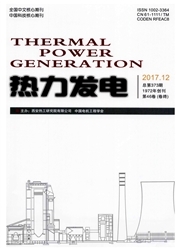

 中文摘要:
中文摘要:
在卡林纳循环基础上增设1个预热器和1个水冷溶液冷却器而构成的三压力氨水动力循环(TPAWPC),能更合理循环能量,节省换热面积,且可生产生活热水。在循环热效率r/t。基础上,考虑余热回收率,选取两者的乘积(动力回收效率7/0)作为评价准则,模拟计算分析了工质工作浓度和基本浓度、循环倍率、透平进口温度等循环重要参数对循环热力性能的影响。结果表明,工质的工作浓度决定了循环工作压力,工质基本浓度必须与工质工作浓度相配合方可获得高效率;循环倍率对循环动力回收效率呈正向较弱影响;当透平进口工质参数为400℃/8MPa,循环最低温度为30℃时,循环热效率和动力回收效率分别为26.05%和22.47%。
 英文摘要:
英文摘要:
By adding a preheater and a water cooling solution cooler on the Kalina cycle, a triple pressure ammoniawater power cycle (TPAWPC) was established,which makes the cycle energy utilization more reasonable, saves the heat exchange area, and can produce domestic hot water. Considering the waste heat recovery rate the power recovery efficiency r/0, which was product of the r/wh and the cycle thermal efficiencywas regarded as the evaluation criterion. Parametric sensitivity study was conducted to discuss the influences of some key parameters on the thermo dynamic performance of the cycle, including the work and basic concentrations, circulation ratio, and the highest temperature of the cycle. The results show that the work concentration deter mines working pressure of the cycle, and the basic concentration should match the work concen tration for high efficiency. The circulation ratio has positive while rather weak effect on the power recovery efficiency with range from 5 to 8. The calculation example presented finally shows that the thermal efficiency and power recovery efficiency reach 26.05 % and 22.47% respectively with the turbine inlet parameters of 400 ℃/8 MPa and the cycle lowest temperature of 30 ℃.
 同期刊论文项目
同期刊论文项目
 同项目期刊论文
同项目期刊论文
 期刊信息
期刊信息
